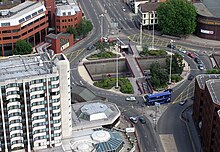Transportation engineering
Transportation engineering or transport engineering is the application of technology and scientific principles to the planning, functional design, operation and management of facilities for any mode of transportation in order to provide for the safe, efficient, rapid, comfortable, convenient, economical, and environmentally compatible movement of people and goods (transport)[citation needed]. It is a sub-discipline of civil engineering.[1] The importance of transportation engineering within the civil engineering profession can be judged by the number of divisions in ASCE(American Society of Civil Engineers) that are directly related to transportation. There are six such divisions (Aerospace; Air Transportation; Highway; Pipeline; Waterway, Port, Coastal and Ocean; and Urban Transportation) representing one-third of the total 18 technical divisions within the ASCE (1987).[2]
The planning aspects of transportation engineering relate to elements of urban planning, and involve technical forecasting decisions and political factors. Technical forecasting of passenger travel usually involves an urban transportation planning model, requiring the estimation of trip generation (how many trips for what purpose), trip distribution (destination choice, where is the traveler going), mode choice (what mode is being taken), and route assignment (which streets or routes are being used). More sophisticated forecasting can include other aspects of traveler decisions, including auto ownership, trip chaining (the decision to link individual trips together in a tour) and the choice of residential or business location (known asland use forecasting). Passenger trips are the focus of transportation engineering because they often represent the peak of demand on any transportation system.
A review of descriptions of the scope of various committees indicates that while facility planning and design continue to be the core of the transportation engineering field, such areas as operations planning, logistics, network analysis, financing, and policy analysis are also important to civil engineers, particularly to those working in highway and urban transportation. The National Council of Examiners for Engineering and Surveying (NCEES) list online the safety protocols, geometric design requirements, and signal timing.
Transportation engineering, as practiced by civil engineers, primarily involves planning, design, construction, maintenance, and operation of transportation facilities. The facilities support air, highway, railroad, pipeline, water, and even space transportation.[1] The design aspects of transportation engineering include the sizing of transportation facilities (how many lanes or how much capacity the facility has), determining the materials and thickness used in pavement designing the geometry (vertical and horizontal alignment) of the roadway (or track).
Before any planning occurs the Engineer must take what is known as an inventory of the area or if it is appropriate, the previous system in place. This inventory or database must include information on (1)population, (2)land use, (3)economic activity, (4)transportation facilities and services, (5)travel patterns and volumes, (6)laws and ordinances, (7)regional financial resources, (8)community values and expectations. These inventories help the engineer create business models to complete accurate forecasts of the future conditions of the systemReview.
Operations and management involve traffic engineering, so that vehicles move smoothly on the road or track. Older techniques include signs, signals, markings, and tolling. Newer technologies involve intelligent transportation systems, including advanced traveler information systems (such as variable message signs), advanced traffic control systems (such as ramp meters), and vehicle infrastructure integration. Human factors are an aspect of transportation engineering, particularly concerning driver-vehicle interface and user interface of road signs, signals, and markings.
Contents
[hide]- 1Highway engineering
- 2Railroad engineering
- 3Port and harbor engineering
- 4Airport engineering
- 5Professional Societies
- 6See also
- 7References
- 8External links

Comments
Post a Comment